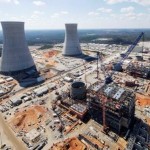The Nuclear Energy Mission for Viksit Bharat was announced as part of the Union Budget of 2025-26. This is a clear signal of policy predictability and making the necessary legislative amendments to enhance India’s nuclear power production through the promotion of private sector participation and acceleration of Research and Development (R&D) and deployment of small modular reactors (SMRs). A sum of $2.3 billion (Rs 20,000 crores) has been allocated for the development of “at least five indigenously designed and operational SMRs by 2033”.
What are SMRs? Why is the government rooting for them? Why is there so much optimism around these? Can the ambitious targets be met? What are the challenges that are likely to come up and how should one approach these?
With the two main attributes of being small and modular, SMRs are nuclear reactors that have a power generation capacity of up to 300 MWe[1] or less, and are designed to be manufactured as modules at factories that can be easily transported to a site for assembly/installation as a product, rather than being laboriously constructed as a greenfield project. This is meant to reduce construction times, offer economies of series production, and flexibility of reactor deployment on land, ship, or even in an underground or submerged environment. Built with existing or new technologies, SMRs are expected to have enhanced safety and security features, particularly because of the lower thermal power of the core and a compact architecture. Hence, they need smaller emergency planning zones due to reduced risk of radiation exposure in case of an accident.
At present, over 70 SMR designs are at different stages on the drawing board across the world. New concepts are being developed, leading to a churn in the nuclear industry with old companies being restructured and new players entering the field.
India has a unique advantage in this space since it has long experience with designing and operating 220 MWe pressurised heavy water reactors, compared with the larger capacity (1000 MWe or more) that most other countries opted to build. A large number of Indian operational reactors with a proven safety and performance record are of the smaller variety. So, while they fit the bill of a small reactor, they have not been modularly built. No country has a modular reactor, as the concept is relatively new.
Motivated by the prospect of SMRs, India has decided to designate these as Bharat Small Modular Reactors (BSMRs) to be produced modularly with some design modifications, which are believed to have been completed[2] and submitted for regulatory approval. .
If this plan proves successful, India could have a few operational BSMRs within a decade from now. In this effort, the country’s main nuclear operator, the Nuclear Power Corporation of India Ltd. (NPCIL), has sought the assistance of the private sector to provide capital, land, and cooling water while it focusses on the design, safety and security of operations and maintenance. This arrangement will not need any legislative changes since NPCIL will remain in charge of nuclear material, technology and operations. India is keen to quickly deploy such reactors in the vicinity of energy-intensive industries such as steel, aluminium and cement.. This will also support India’s energy transition to net zero emissions in the coming decades.
Apart from BSMRs, the Department of Atomic Energy is also designing SMRs with newer technologies. Their deployment is being considered for niche areas such as providing back-up for the renewable energy in the country; repurposing existing infrastructure of decommissioned coal plants; or, meeting electricity needs of remote areas such as high mountains or islands. These could also be developed with foreign collaboration. Recent joint statements that India has signed with countries that have advanced nuclear programmes, such as the U.S[3]. and France[4], specifically mention collaborative development of SMRs This will help India gain from technological developments elsewhere whilst pitching itself as a component and equipment manufacturing hub in the nuclear supply chain, including for SMRs if some of these designs achieve standardisation.
To get there, two dimensions are necessary. First, one or two of the new reactor designs will need to be finalised and put up for domestic regulatory approval. The advantage of economy of production can be enjoyed only when a design is standardised and set for modular manufacture. This maturity is regrettably a distance away.
Second, it requires large-scale involvement of the private industry which, in turn, will require an amendment to the Civil Liability for Nuclear Damage Act (CLNDA). India had passed this law in 2010, coincidentally also the time when the Bhopal gas verdict was delivered amidst a sense of anger and despondency on how long it had taken for justice to be delivered to the victims of the 1984 Union Carbide factory gas leak tragedy. So, the mood was in favour of a stringent law that would ensure quick remedy in case of a nuclear accident. Accordingly, the law placed a liability on the operator to simplify the process for victims to seek compensation. But in a departure from global norms, it also allowed recourse against the supplier in case of a nuclear incident resulting from a design defect or substandard equipment. This clause dampened private industry enthusiasm. While the government did announce a Rs 1,500 crore Indian nuclear insurance pool (INIP) in 2015 to mitigate supplier risks, domestic and foreign private companies have since remained sceptical.
This can change. While announcing the budget this year, the government has hinted at an amendment of the law to incentivize private players to partner along with NPCIL on SMRs and larger reactors. Indeed, the proposed legislative reforms offer a fresh opportunity to unlock the potential of domestic and foreign private investment and accelerate India’s clean energy transition. While speed is desirable, it must not be at the cost of a robust regulatory framework that harmonises growth with accountability. Any safety lapse will prove to be harmful for the entire nuclear programme.
India cannot afford any such eventuality since the benefit of nuclear energy as a low carbon and environmentally friendly source is critical for meeting the country’s increasing electricity requirement. This will expand as India increases its manufacturing base, alongside the service industry, both of which require a stable electricity grid, driven by larger capacity reactors of 1,000 MWe or more, not SMRs. Even as India remains invested in the larger capacity reactors for fulfilling the country’s massive energy requirement, SMR development can move swiftly, offering scope for necessary additions at specific points, so overall, India can ensure stable and sustainable electricity targets in line with its demographic and aspirational requirements.
Manpreet Sethi is Distinguished Fellow, Centre for Air Power Studies, and Senior Research Advisor, Asia Pacific Leadership Network.
This article was exclusively written for Gateway House: Indian Council on Global Relations. You can read exclusive content here.
Support our work here.
For interview requests with the authors, or for permission to republish, please contact outreach@gatewayhouse.in.
© Copyright 2025 Gateway House: Indian Council on Global Relations. All rights reserved. Any unauthorized copying or reproduction is strictly prohibited.
References:
[1] When a nuclear reactor is being operated for producing electricity, its capacity is referred to as MWe in contrast to research reactors that are being used for other purposes such as research or production of radioisotopes, in which case it is referred to as MW.
[2] Jacob Koshy, Design stage of small modular nuclear reactor completed: Jitendra Singh, The Hindu, March 13, 2025.
https://www.thehindu.com/sci-tech/science/design-stage-of-bharat-small-modular-nuclear-reactor-complete/article69322209.ece
[3] Ministry of External Affairs, India – U.S. Joint Statement (February 13, 2025), February 13, 2025.
https://www.mea.gov.in/bilateral-documents.htm?dtl/39066
[4] Ministry of External Affairs, India – France Joint Statement on the visit of Shri Narendra Modi, Hon’ble Prime Minister of India to France (10-12 February 2025), February 12, 2025. https://www.mea.gov.in/bilateral-documents.htm?dtl/39071/india++france+joint+statement+on+the+visit+of+shri+narendra+modi+honble+prime+minister+of+india+to+france+1012+february+2025


